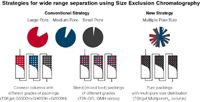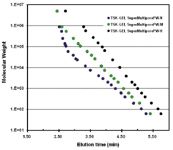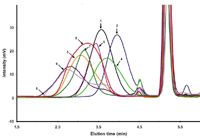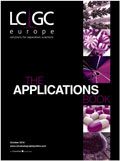Analysis of Water-Soluble Polymers Using Linear Size Exclusion HPLC Columns and a Semi-micro SEC System
The Application Notebook
In recent years water-soluble polymers are gaining more and more interest in different applications. The molecular weight distribution of polymers is usually characterized by size exclusion chromatography (SEC) coupled with refractive index, viscometric or laser light scattering detection. Recent advances in SEC comprise semi-micro SEC and the design of linear columns providing wide molecular weight separation ranges and near-linear calibrations. We describe the separation of water-soluble polymers with a new generation of linear, polymer-based, semi-micro SEC columns using the compact EcoSEC SEC system.
Regina Roemling, Tosoh Bioscience GmbH.
In recent years water-soluble polymers are gaining more and more interest in different applications. The molecular weight distribution of polymers is usually characterized by size exclusion chromatography (SEC) coupled with refractive index, viscometric or laser light scattering detection. Recent advances in SEC comprise semi-micro SEC and the design of linear columns providing wide molecular weight separation ranges and near-linear calibrations. We describe the separation of water-soluble polymers with a new generation of linear, polymer-based, semi-micro SEC columns using the compact EcoSEC SEC system.
Introduction
One of the most widely used water-soluble polymers is Polyvinylpyrrolidone (PVP). For more than 70 years it has been applied in a variety of applications in medicine, pharmacy, cosmetics and industrial production. PVP binds to polar molecules exceptionally well. It supports the solubility of tablets in water, makes the glue stick adhesive and plays an essential role in the production of membranes. In ceramic, paper and dye applications, it produces visual effects such as gloss and brilliancy. As a food additive, PVP is a stabilizer and has E number E1201. Other water-soluble polymers such as dextrans found a wide application in medicine and biotechnology as well as in the food industry. A characteristic feature of a certain polymer is its molecular weight distribution curve, which is usually obtained by gel chromatography.
Linear SEC Columns
The latest progress in size exclusion chromatography (SEC) column technology was the development of columns with an extended linear calibration range. A linear molecular weight calibration curve covering an extended molecular weight operation range can be obtained in different ways. The traditional and simplest way is to couple different columns, each containing particles with distinct pore size distributions. It is inevitable that the resulting calibration curve will deviate from linearity between each pore size range, resulting in irregularities in the chromatogram. Therefore, mixed-bed columns were developed to overcome column mismatches. Mixed-bed columns are prepared by mixing batches of particles each containing a narrow pore size distribution. However, inflection points in chromatograms can still arise as a result of a mismatch of pore sizes.
Figure 1: Multi-pore technology.

The latest development in SEC column design, the multi-pore particle synthesis technology can provide a real solution to avoid inflection points. Particles prepared by multi-pore technology contain a broad range of pore sizes in a single polymeric bead. This innovative approach essentially creates a linear calibration curve within each particle (Figure 1).
Figure 2: Calibration curves for TSK-GEL uperMultiporePW columns. Mobile phase: H2O, flow rate: 0.6 mL/min, RI detection, 25 °C, PEO and PEG standards.

The multi-pore particle synthesis technology has been successfully applied to TSK-GEL GPC columns for organic SEC for some years. Now the same strategy is used to design multi-pore particles of the polymethacrylate based TSK-GEL PW type packing for aqueous SEC. The new TSK-GEL SuperMultiporePW columns are packed with spherical mono-disperse polymethacrylate particles, each containing a wide range of pore sizes. Based on their small particle sizes it is possible to reach high theoretical plates at half of the length of a conventional SEC column of 30 cm length. The TSK-GEL SuperMultipore PW series comprises of three column types covering different molecular weight ranges (PW-N; PW-M, PW-H). They exhibited high resolution and good linearity of the calibration curves across a wide range of molecular masses of PEO and PEG standards in aqueous eluent as shown in Figure 2. With dimensions of 6 mm i.d. and 15 cm length they belong to the semi-micro type of SEC columns.
Semi-micro SEC
Semi-micro column dimensions are advantageous in terms of shorter analysis time, lower solvent consumption and reduced solvent disposal cost. To fully exploit the advantages of semi-micro SEC columns, the HPLC system needs to be optimized to minimize extra column peak broadening. This means first of all minimization of dead volume. Key components of the HPLC system, with regards to dead volume reduction, are the void volumes of tubings, the cell volume of the detector cell and the void volume of the injection unit. EcoSEC is a compact, all-in-one SEC system that was designed to perform both, semi-micro and conventional SEC. Key features of the system are the low system dead volume, outstanding pump reproducibility and an extremely stable baseline of the dual flow refractive index (RI) detector. The RI detector is designed in a way that the pure mobile phase is permanently rinsing the reference site of the detector cell. Tedious purging with pure solvent using a purge valve at the start of a batch and after changing the solvent bottle becomes redundant. Extraordinary fast equilibrium and set-up times can be achieved. The solvent in the sample site and the reference site of the cell always has the same quality and temperature. This leads to extremely stable baselines allowing proper integration and processing of the smallest peaks. Apart from the dual-flow design, the small size of the RI's detector cell is advantagous. The small volume of only 2.5 μL minimizes peak broadening. The EcoSEC SEC system offers outstanding performance, high sensitivity and short analysis time when combined with TSK-GEL semi-micro SEC columns.
Analysis of Water-Soluble Polymers
Figure 3: Analysis of polyvinylpyrrolidone. Columns: TSKgel SuperMultiporePW-M (6 mm i.d. × 15 cm L × 1) (red); TSKgel G3000PWXL and G5000PWXL (each 7.8 mm i.d. × 30 cm L.) in line (blue), sample: polyvinylpyrrolidone (K-30).

Water-soluble synthetic polymers were analysed using the EcoSEC SEC system with RI detection and the newly developed TSKgel SuperMultiporePW-M (5 μm particle size, 6 mm i.d. × 15 cm L) size exclusion column with 0.1 M NaNO3 as mobile phase. Injection volume was 35 μL and flow rate 0.6 mL/min at 25 °C.
Figure 4: Analysis of water-soluble polymers. Column: TSKgel SuperMultiporePW-M (6 mm i.d. × 15 cm L), samples: 1 = polyvinylpyrrolidone (K-30), 2 = polyvinylpyrrolidone (K-15), 3 = hydroxypropylcellulose (200 K) 4 = hydroxypropylcellulose (100 K), 5 = chondroitin sulphate sodium salt, 6 = carboxymethyl cellulose, 7 = arabic gum, 8 = poly(sulphopropyl methacrylate-co-acrylic acid), 9 = dextran (200K).

Figure 3 shows the SEC analysis of a real sample - Polyvinylpyrrolidone (PVP) K-30 - on a series of conventional TSKgel G3000PWXL and G5000PWXL columns compared to the one obtained with a single TSKgel SuperMultiporePW-M semi-micro linear SEC column (MW range 600000–1500000). When analysed with a series of conventional SEC columns the Polyvinylpyrrolidone peak shows an inflection point, which does not appear on the SuperMultiporePW-M column. As a result of its smaller particle size and the semi-micro column dimensions, analysis is much faster and more sensitive when applying the new multi-pore packing. Figure 4 shows the SEC elugrams of various water-soluble polymers obtained on a TSKgel SuperMultiporePW-M column.
Conclusion
Chromatograms obtained on TSK-GEL SuperMultiporePW columns show high resolution and smooth peak shapes without shoulders or inflection points, thus allowing better accuracy and reproducibility when determining the molecular mass distribution of water soluble polymers. Various polymers and oligomers were analysed on the TSK-GEL SuperMultiporePW semi-micro columns. Compared with conventional SEC columns, the TSK-GEL SuperMultiporePW columns delivered superior results at shorter run times and lower solvent consumption. The results illustrate the advantages of these materials over traditional columns for aqueous SEC.

Tosoh Bioscience GmbH
Im Leuschnerpark 4
64347 Griesheim
tel. +49 6155-7043700
fax +49 6155-8357900
E-mail: Info.tbg@tosoh.com
Website: www.tosohbioscience.de

Accelerating Monoclonal Antibody Quality Control: The Role of LC–MS in Upstream Bioprocessing
This study highlights the promising potential of LC–MS as a powerful tool for mAb quality control within the context of upstream processing.
Using GC-MS to Measure Improvement Efforts to TNT-Contaminated Soil
April 29th 2025Researchers developing a plant microbial consortium that can repair in-situ high concentration TNT (1434 mg/kg) contaminated soil, as well as overcome the limitations of previous studies that only focused on simulated pollution, used untargeted metabolone gas chromatography-mass spectrometry (GC-MS) to measure their success.
Prioritizing Non-Target Screening in LC–HRMS Environmental Sample Analysis
April 28th 2025When analyzing samples using liquid chromatography–high-resolution mass spectrometry, there are various ways the processes can be improved. Researchers created new methods for prioritizing these strategies.
Potential Obstacles in Chromatographic Analyses Distinguishing Marijuana from Hemp
April 28th 2025LCGC International's April series for National Cannabis Awareness Month concludes with a discussion with Walter B. Wilson from the National Institute of Standard and Technology’s (NIST’s) Chemical Sciences Division regarding recent research his team conducted investigating chromatographic interferences that can potentially inflate the levels of Δ9-THC in Cannabis sativa plant samples, and possible solutions to avoid this problem.

.png&w=3840&q=75)

.png&w=3840&q=75)



.png&w=3840&q=75)



.png&w=3840&q=75)



















